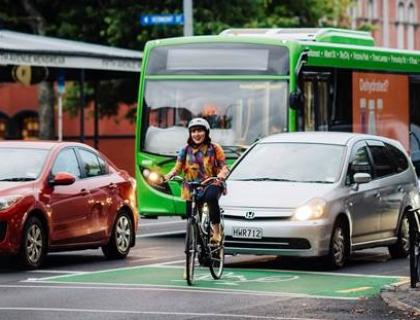Cycling Safety at Urban Intersections (Completed)
Intersections are busy places with traffic coming from multiple directions, pedestrians crossing and other distractions. They demand extra attention and this is heightened when cyclists are also present.
The AA Research Foundation (AARF) and NZ Transport Agency (NZTA) want to better understand cyclist-motorist interactions.
Both organisations want intersections to be safer and more comfortable for cyclists and motorists.
Research programme
During 2017, AARF and NZTA jointly funded research that looked at video footage at peak hours from four urban intersections – two each in Wellington and Auckland.
They were intersections with high numbers of cyclists and vehicle movements so that the number of interactions was maximised. Using a combination of “computer vision” and human analysis, all of the vehicle–cycle interactions were analysed.
The study aimed to capture everything from lower level avoiding or negotiated behaviour to near misses and collisions.
The research methods were innovative so initially a pilot study was done.
In a second piece of research, AARF collaborated with NZTA. with both organisations seeing value in combining resources on this issue.
Expert Steering Group
- Simon Douglas - AA Research Foundation Manager
- Peter King - AA Research Foundation Advisor
- Gerry Dance - NZ Transport Agency
- Tim Hughes - NZ Transport Agency
- James Burgess - Cycle Action Network
- Brett McPhedron - Wellington City Council
- Kathryn King - Auckland Transport
Project scoping document
Understanding conflicts between cyclists and other road users at urban intersections
Final report
Cyclist conflict at urban intersections (June 2018)
Background information: cycling-motorist collision statistics
There are a number of risks for cyclists that do not affect car drivers - primarily decreased stability and a much lower level of protection. A cyclist is also less visible to other road users than a car or truck.
From 2011-2015, on average eight cyclists were killed each year and 777 were injured. In 2015, 100 cyclists were hospitalised for over one day due to injuries from crashes with vehicles on public roads.
As with all road casualties, numbers have trended down since the 1990s, but cycling remains riskier than driving.
Cyclists are 10 times more likely to be involved in a serious or fatal injury compared to car drivers. Research shows that this increased level of risk puts many people off cycling.
In about 66% of collisions between a vehicle and a cyclist the vehicle drivers are found to have primary responsibility.
- 64% of drivers in fatal or injury crashes involving cyclists failed to give way or stop
- 59% of drivers did not see the cyclist
- 13% of drivers were found inattentive or their attention was diverted
In the remaining third of incidents where the cyclist was responsible (or partly), often they are child/youth cyclists.
Around 90% of reported cyclist causalities are on urban roads (70km/h speed limit or less) and the morning (8–10am) and the early evening (4–6pm) are when most incidents occur.
AA Members views on cycling
-
11% of AA Members consider themselves cyclists, with middle-aged men the most regular cyclists.
-
Designated cycling and equestrian routes are strongly supported.
-
Cycling infrastructure spending is supported by AA Members, both those who cycle regularly and those who don’t, generally at a similar level to bus funding.
-
Cycle lanes with visual and physical separation from footpaths and traffic are favoured.
AA Members favour painted cycle lanes, separated on one side from the footpath by a curb and on the other side with bollards separating the cycle lane from traffic (and any vehicle parking allowance also on the traffic side of the bollards). The least preferred design is what is seen most often in NZ – cycle lanes that are merely marked lanes on roads, often inadequately painted.
-
Top driver feelings about cyclists are:
- concern about hitting cyclists
- respect that the person is cycling
- annoyance at cyclists’ lack of consideration.
Lack of personal cycling experience correlates with greater concern and annoyance. Women show more concern and less annoyance than others.
-
‘Just not my thing’ and too scary and unsafe are the biggest reasons for not cycling, although impractical and too busy are also significant.
-
Most AA Members ride for sport/exercise rather than every day trips (work, shops, etc.).
-
Wearing helmets while cycling is overwhelmingly supported.
AA position on cycling
Read about the AA's views on how motorists and cyclists can safely share our roads:
Sharing the road with cyclists
Page last updated: December 2020

